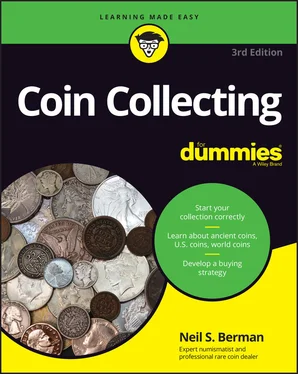Neil S. Berman - Coin Collecting For Dummies
Здесь есть возможность читать онлайн «Neil S. Berman - Coin Collecting For Dummies» — ознакомительный отрывок электронной книги совершенно бесплатно, а после прочтения отрывка купить полную версию. В некоторых случаях можно слушать аудио, скачать через торрент в формате fb2 и присутствует краткое содержание. Жанр: unrecognised, на английском языке. Описание произведения, (предисловие) а так же отзывы посетителей доступны на портале библиотеки ЛибКат.
- Название:Coin Collecting For Dummies
- Автор:
- Жанр:
- Год:неизвестен
- ISBN:нет данных
- Рейтинг книги:4 / 5. Голосов: 1
-
Избранное:Добавить в избранное
- Отзывы:
-
Ваша оценка:
- 80
- 1
- 2
- 3
- 4
- 5
Coin Collecting For Dummies: краткое содержание, описание и аннотация
Предлагаем к чтению аннотацию, описание, краткое содержание или предисловие (зависит от того, что написал сам автор книги «Coin Collecting For Dummies»). Если вы не нашли необходимую информацию о книге — напишите в комментариях, мы постараемся отыскать её.
Coin Collecting For Dummies,
numismatics
Coin Collecting For Dummies
Coin Collecting For Dummies — читать онлайн ознакомительный отрывок
Ниже представлен текст книги, разбитый по страницам. Система сохранения места последней прочитанной страницы, позволяет с удобством читать онлайн бесплатно книгу «Coin Collecting For Dummies», без необходимости каждый раз заново искать на чём Вы остановились. Поставьте закладку, и сможете в любой момент перейти на страницу, на которой закончили чтение.
Интервал:
Закладка:
“Where in the world did you get that?”
“I haven’t seen one of those for years.”
“My grandpa used to give me one of those every year for my birthday.”
“Is that a real silver dollar?”
“Can you get me one?”
Return the coin to your pocket, and pull out a picture of your kid or your dog. Almost everyone has a kid or a dog so the party returns to normal. Boring!
Collecting versus Accumulating
The collecting instinct is a common trait among people; it shows up in many ways. You’ll discover that many of your friends are collectors of something. Who do you know who collects baseball cards, comic books, vinyl, Coca-Cola memorabilia, books, or dolls? Even people who claim to collect nothing probably have accumulations of something they haven’t even realized they’re accumulating — tools, newspapers, shoes, you name it. There’s a special comfort in collecting, in surrounding yourself with familiar objects and building a store of assets — perhaps in response to some primeval instinct that prepares you for a rainy day.
The allure of money is especially strong. Coins represent real value. Coins can be exchanged for other objects we desire. Coins travel throughout the world and through time itself, representing and absorbing history as they pass from one person to the next. Oh, the stories coins could tell if only they had voices! And they’re everywhere, because no one anywhere ever throws away old money.
Pull a dime out of your pocket, and what do you see? If all you see is 10 cents to spend, I’ve got a lot of work to do. But if you look at your dime and wonder at the artistic work of the engraver and the meaning of the symbols and the words, or if you see Franklin Roosevelt, the Great Depression, and the New Deal, groovy you’re hooked! You’re going to make a great coin collector and, perhaps, one day, a numismatist!
 I make a distinction in this book between numismatists (those who study coins) and coin collectors (those who collect coins). You can be a numismatist without being a coin collector, you can be a coin collector without being a numismatist, or you can be both.
I make a distinction in this book between numismatists (those who study coins) and coin collectors (those who collect coins). You can be a numismatist without being a coin collector, you can be a coin collector without being a numismatist, or you can be both.
 Not sure whether you have that collecting instinct? Here’s a great way to find out whether you’re an accumulator or whether you have the potential to become a coin collector:
Not sure whether you have that collecting instinct? Here’s a great way to find out whether you’re an accumulator or whether you have the potential to become a coin collector:
1 Visit your local coin store or online, and purchase a folder made for pennies from the ’80s, ’90s, and 2000s.A folder is a cardboard holder with holes for every date.
2 Raid your change jar, or go to the bank and buy $20 worth of pennies.
3 Sort out the coins, and fill as many spotsholes as you can.If possible, find the best-looking coins to place in the folder.WHAT MAKES A COLLECTION COMPLETE?Completion is in the eye of the beholder. Many years ago, some coin collectors were interested only in collecting by date. Therefore, to be complete, a collection had to include one coin from every year that the coin was minted. Later, collectors developed an interest in mintmarks — the tiny letters that indicate where a coin was minted. Suddenly, to be complete, a collection had to include a coin from every year and from every mint. Then came collecting by variety (major or minor changes in the design of a coin), and the definition of completion expanded even further.Obviously, completion is an ever-changing standard. Taken to the extreme, the only complete collection of coins is one that includes every coin ever made! Striving for completion will drive you nuts. Instead, decide on your own goals, and set your own standards for completion. When you’ve completed that collection, consider a new definition of completion, and go for it! Remember: There’s no “correct” way to collect.
4 After you’ve gone through all the coins, sit back and take a look at your work.Do you wonder why some coins were harder to find than others? Do you wonder why you couldn’t find even a single example of some coins? Are you interested in completing the set? Did you have fun searching through the coins?If you answered yes to any of these questions, you’ve discovered the difference between being a collector and an accumulator — and in case you’re wondering, you’re a collector.
Collecting Various Types of Coins
Throughout the years, people around the world have experimented with a variety of items used to denote value. The natives of Papua New Guinea valued the dried carcasses of the beautiful bird of paradise. The Yap Islanders valued huge round stones. The early Chinese created copper money in the shape of knives. Native Americans made and used wampum (clamshells, handmade into beads, polished, drilled, and strung on strands of leather) as a medium of exchange. All sorts of innovative methods have been used to facilitate trading, but none of them became so convenient and important as those little round pieces of metal we call coins.
Gold and silver coins
Look at the history of coins, and you’ll notice that two metals have played a critical part in the development of money: gold and silver. These two metals formed the basis of most great civilizations’ systems of money. Greece, Rome, Egypt, Spain, England, the United States, and other civilizations all based their monetary systems on gold and silver at one time or another. When you hear about the great treasures of the world, you imagine piles of gold and silver, not piles of tin and copper. Why have people throughout the ages been so in love with gold and silver when there are plenty of other metals?
Gold is popular because it’s
Rare: Gold is one of those metals that has been recognized as being rare and desirable for more than 6,000 years, but it isn’t so rare that it’s impossible to find.
A naturally occurring element: Gold is found in nature as flakes or nuggets on the surface of the Earth, in rivers, or in thin veins buried deep within the Earth. The purity of natural gold may vary from one location to the next, but it requires little processing to achieve a uniform quality. There’s gold to be found on every continent.
Malleable: Pure gold is soft and can be beaten into extremely thin sheets or pulled into long wires or strips. Because it’s so soft, gold takes good impressions from dies (the steel cylinders used to strike coins), and it won’t wear them out as fast as a harder metal would. Or it can be alloyed with other metals and made as hard as you want.
Reasonably inert: In nature or in normal use, gold won’t react with moisture, oxygen, or human skin, which means that jewelry and coins made of gold will last virtually forever.
Beautiful: Pure gold has a soft yellow color and a gorgeous sheen that has appealed to people’s visual senses since we lived in caves. Mix gold with silver or copper, and you’ll come up with an interesting range of colors. The colors that come up most frequently on U.S. gold coins are pale reds, light greens, soft pinks, and white.
 Many collectors prefer coins that are white and untarnished; other collectors pay huge premiums for coins with natural, bright, rainbow-colored tarnish known to collectors as toning. Be aware that toning isn’t always natural and can — whether it’s natural or not — often hide flaws and defects that could dramatically lower the value of the coin, which is just one reason why serious collectors collect certified coins.
Many collectors prefer coins that are white and untarnished; other collectors pay huge premiums for coins with natural, bright, rainbow-colored tarnish known to collectors as toning. Be aware that toning isn’t always natural and can — whether it’s natural or not — often hide flaws and defects that could dramatically lower the value of the coin, which is just one reason why serious collectors collect certified coins.
Интервал:
Закладка:
Похожие книги на «Coin Collecting For Dummies»
Представляем Вашему вниманию похожие книги на «Coin Collecting For Dummies» списком для выбора. Мы отобрали схожую по названию и смыслу литературу в надежде предоставить читателям больше вариантов отыскать новые, интересные, ещё непрочитанные произведения.
Обсуждение, отзывы о книге «Coin Collecting For Dummies» и просто собственные мнения читателей. Оставьте ваши комментарии, напишите, что Вы думаете о произведении, его смысле или главных героях. Укажите что конкретно понравилось, а что нет, и почему Вы так считаете.












